The “Gutâi-Maramureș” UNESCO Geopark Project Development and Heritage Values-Based Sustainable Tourism in the Gutâi Volcanic Zone, East Carpathians (Romania)
Abstract
1. Introduction
1.1. Previous Research
1.2. Scope
1.3. Geological Background
- Early felsic (i.e., rhyolitic), caldera-related explosive volcanism, starting at 15.4 Ma [26], fully correlated with the formation of the rhyolitic Dej Tuff Complex of the same age in the neighboring Transylvanian Basin and partially correlated with the widespread rhyolitic volcanism in the Pannonian Basin. Its products (ignimbrites and their resedimented counterparts) occur in the southwestern part of the GVZ (Figure 2a).
- Intermediate (mostly andesitic) volcanism developed in the 13.4–7.0 Ma time interval [25] when a variety of volcanic rocks, ranging from basalts to rhyolites, were emplaced in the entire area of the GVZ. This volcanic activity, reaching its climax between 11 and 9 Ma, comprised four phases [27]: (1) between 13.4 and 12.1 Ma, generating andesitic shield volcanoes, lava flows and extrusive domes in the southeastern and southwestern part of the GVZ (Figure 2a); (2) paroxysmal activity between 11.6 and 9.0 Ma, producing predominantly medium-K basaltic andesites, andesites and dacites constructing the most voluminous volcanic structures in the central and northern parts of the area (Mogoşa and Igniş composite volcanoes), the large-sized Gutâi and Pleşca Mare extrusive domes and extended lava plateaus (Figure 2a), while shallow subvolcanic intrusions (dykes, sills, small-sized laccoliths) dated between 11.8 and 9.0 Ma occur mainly in the southeastern part of the volcanic area; (3) a small-sized composite andesite–dacite intrusive structure, the Laleaua Albă magmatic complex (8.5–8.0 Ma, located in the central–southern part of the volcanic area, represents the third volcanic stage (Figure 2a); and (4) the fourth volcanic stage, consisting of several small-sized intrusive bodies of olivine-bearing basalts (the Firiza basaltic complex, 8.1–7.0 Ma [28]), developed in the central part of the GVZ (Figure 2a).
2. Materials and Methods
3. Results
3.1. Geological Heritage
3.2. Mining Heritage
3.3. Natural Heritage
3.4. Cultural Heritage
4. Discussion
5. Conclusions
Author Contributions
Funding
Data Availability Statement
Acknowledgments
Conflicts of Interest
References
- Zouros, N. The European Geoparks Network. Geological heritage protection and local development. Episodes 2004, 27, 165–171. [Google Scholar]
- Zouros, N. Global Geoparks Network and the new UNESCO Global Geoparks Programme. Bull. Geol. Soc. Greece 2016, 50, 284–292. [Google Scholar]
- UNESCO Global Geoparks. Available online: https://www.unesco.org/en/iggp/geoparks/about (accessed on 25 January 2024).
- Global Geoparks Networks. Available online: https://www.globalgeoparksnetwork.org/ (accessed on 25 January 2024).
- Martini, G.; Zouros, N. Geoparks a vision for the future. Geosciences 2008, 8, 182–189. [Google Scholar] [CrossRef]
- Alexandrowicz, Z.; Kozlowski, S. From selected geosites to geodiversity conservation—Polish example of modern framework. In Towards the Balanced Management and Conservation of the Geological Heritage in the New Millenium; Barettino, D., Vallejo, M., Gallego, E., Eds.; Sociedad Geológica de España: Madrid, Spain, 1999; pp. 40–44. [Google Scholar]
- Kozlowski, S. Geodiversity. The concept and scope of geodiversity. Prz. Geol. 2004, 52, 833–837. [Google Scholar]
- Gray, M. Geodiversity: Valuing and Conserving Abiotic Nature; John Wiley and Sons: New York, NY, USA, 2004; p. 434. [Google Scholar]
- Gray, J.M. Geodiversity: Developing the paradigma. Proc. Geol. Assoc. 2008, 119, 287–298. [Google Scholar]
- Brilha, J. Inventory and quantitative assessment of geosites and geodiversity sites: A review. Geoheritage 2016, 8, 119–134. [Google Scholar]
- Reynard, E.; Brilha, J. Geoheritage: A multidisciplinary and applied research topic. In Geoheritage: Assessment, Protection, and Management; Elsevier: Amsterdam, The Netherlands, 2018; pp. 3–9. [Google Scholar]
- Hose, T.A. European geotourism—Geological interpretation and geoconservation promotion for tourists. In Geological Heritage: Its Conservation and Management; Barretino, D., Wimbledon, W.A.P., Gallego, E., Eds.; Instituto Tecnologico GeoMinero de Espana: Madrid, Spain, 2000; pp. 127–146. [Google Scholar]
- Buckley, R. Research note: Environmental Inputs and Outputs in Ecotourism; Geotourism with a Positive Triple Bottom Line? J. Ecotour. 2003, 2, 76–82. [Google Scholar]
- Dowling, R.K. Geotourism’s Global Growth. Geoheritage 2011, 3, 1–13. [Google Scholar]
- Hose, T.A. Editorial: Geotourism and Geoconservation. Geoheritage 2012, 4, 1–5. [Google Scholar]
- Newsome, D.; Dowling, R. Geoheritage and Geotourism. In Geoheritage Assessment, Protection, and Management; Elsevier: Amsterdam, The Netherlands, 2018; pp. 305–321. [Google Scholar]
- Istvan, D.; Bernad, A.; Edelstein, O. Possibilities of valorization and protection of the geotourism potential of the Volcanic Mountains in Maramureș County. In Proceedings of the 4th National Colloquium on the Geography of Tourism, București, Romania; 1977; pp. 97–104. (In Romanian). [Google Scholar]
- Kovacs, M.; Fülöp, A. Baia Mare Geological and Mining Park—A potential new Geopark in the northwestern part of Romania. Stud. Univ. Babes-Bolyai Geol. 2009, 54, 27–32. [Google Scholar]
- Fülöp, A.; Kovacs, M. Managing the geodiversity in Baia Mare region; from scientific to public interest. Stud. Univ. Babes-Bolyai Geol. 2010, 55, 5–8. [Google Scholar]
- Szakács, A.; Kovacs, M. Volcanic Landforms and Landscapes of the East Carpathians (Romania) and Their Geoheritage Values. Land 2022, 11, 1064. [Google Scholar] [CrossRef]
- Kovacs, M.; Szakács, A.; Denuț, I.; Gál, Á. Geosite assessment in a volcanic area. Case study: Miocene Gutâi Volcanic Zone, NW Romania. In Proceedings of the Volcandpark 2024, Jičin, Czech Republic, 20–24 May 2024; pp. 29–30. [Google Scholar]
- Pécskay, Z.; Lexa, J.; Szakács, A.; Seghedi, I.; Balogh, K.; Konecny, V.; Zelenka, T.; Kovacs, M.; Póka, T.; Fülöp, A.; et al. Geochronology of Neogene magmatism in the Carpathian arc and intra-Carpathian area. Geol. Carpath. 2006, 57, 511–530. [Google Scholar]
- Physical Map of Europe. Available online: https://ontheworldmap.com/europe/physical-map-of-europe.jpg (accessed on 28 December 2024).
- Maps on the Web. Territory of the Carpathian Mountains Laying in Different Countries. Available online: https://mapsontheweb.zoom-maps.com/post/638740939534385152/territory-of-the-carpathian-mountains-laying-in (accessed on 28 December 2024).
- Kovacs, M.; Fülöp, A. Neogene volcanism in Gutâi Mts. (Eastern Carpathians). A review. Stud. Univ. Babes-Bolyai Geol. 2003, 48, 3–16. [Google Scholar] [CrossRef]
- Fülöp, A. Transport and emplacement of the 15.4 Mă rhyolitic ignimbrites from Gutai Mts., Eastern Carpathians, Romania. Stud. Univ. Babes-Bolyai Geol. 2002, XLVII, 65–75. [Google Scholar] [CrossRef][Green Version]
- Kovacs, M.; Seghedi, I.; Yamamoto, M.; Fülöp, A.; Pécskay, Z.; Jurje, M. Miocene volcanism from the Oaş-Gutâi Volcanic Zone (Eastern Carpathians, România)—Link to the geodynamic processes of Transcarpathian Basin. Lithos 2017, 294, 304–318. [Google Scholar]
- Edelstein, O.; Pécskay, Z.; Kovacs, M.; Bernad, A.; Crihan, M.; Micle, R. The age of the basalts from Firiza zone, Igniş Mts., East Carpathians, Romania. Révue Roum. Geol. 1993, 37, 37–41. [Google Scholar]
- Lang, B.; Edelstein, O.; Steinitz, G.; Kovacs, M.; Halga, S. Ar-Ar dating of adularia—A tool in understanding genetic relations between volcanism and mineralization: Baia Mare area (Gutâi Mountains), northwestern Romania. Econ. Geol. 1994, 89, 174–180. [Google Scholar]
- Direcția Județeană de Cultură Maramureș. Lista Monumentelor Istorice din Maramureș. Available online: https://www.cultura-maramures.ro/wp-content/uploads/2020/06/LMI-MM-2015.pdf (accessed on 8 January 2025).
- Direcția Județeană de Cultură Maramureș. Available online: https://www.cultura-maramures.ro/patrimoniul-cultural/patrimoniu-unesco (accessed on 8 January 2025).
- Gál, Á.; Szakács, A.; Ionescu, C.; Kovacs, M. Mineral- and rock type localities in Romania and their potential geoheritage value. Geoheritage 2024, 16, 5–26. [Google Scholar] [CrossRef]
- Denuţ, I.; Kovacs, M.; Bereș, I.; Sîngeorzan, A. A cultural institution as a geotourism attraction: Baia Mare Mineralogical Museum (Romania). In Proceedings of the XXII International Congress of the Carpathian Balkan Geological Association, Plovdiv, Bulgaria, 7–11 September 2022; p. 237. [Google Scholar]
- Manilici, V.; Giușcă, D.; Stiopol, V. Study of Baia Sprie ore deposit. In Memoriile Comitetului Geologic; Institutul Geologic Bucuresti: Bucuresti, Romania, 1965; Volume VII, pp. 1–95. (In Romanian) [Google Scholar]
- Haidinger, W.M.W. Uber den Felsőbanyit, eine neue Mineralspecies. Sitzungsberichte Math.-Naturwissenschaftlichen Cl. Kais. Akad. Wiss. 1854, 12, 183–190. [Google Scholar]
- Schroeckinger, J. Dietrichit, ein neuer Alaun aus Ungarn. Verhandlungen K.K. Geol. Reichsanst. Wien 1878, 1878, 189–191. [Google Scholar]
- Schroeckinger, J. Vortrage. II. Szmikit, ein neues mangansulphat. Verhandlungen Kais. -K. Geol. Reichsanst. 1877, 1877, 115–117. [Google Scholar]
- Krenner, J.S. A new lead ore found at Felsőbanya. Magy. Tudományos Akadémia Értesitője 1881, 15, 111–113. [Google Scholar]
- Krenner, J.S. Andorit, új hazai ezüstércz. Mathem Természettudom Értesitő 1892, 11, 119–122. (In Hungarian) [Google Scholar]
- Moëlo, Y.; Makovicky, E.; Karup-Møller, S. New data on the minerals of the andorite series. Neues Jahrb Miner. Mon. 1984, 1984, 175–182. [Google Scholar]
- Zsivny, V. Klebelsbergit, ein neues Mineral von Felsőbanya. Mat. Természettudományi Értesitő 1929, 46, 19–26. [Google Scholar]
- Hausmann, J.F.L. Rhodochrosit. In Handbuch der Mineralogie, 2nd ed.; Vandenhoek und Ruprecht: Gottingen, Germany, 1813; Volume 3, p. 302. [Google Scholar]
- Krenner, J.S.; Loczka, J. Fizelyit, egy új magyar ezüstérc. Mathem Természettudom Értesitő 1923, 40, 18–21. [Google Scholar]
- de Finaly, I.; Koch, S. Fülöppite, a new Hungarian mineral of the plagionite-semseyite group. Mineral Mag. 1929, 22, 179–184. [Google Scholar]
- Topa, D.; Sicher, P.; Keutsch, F.; Kolitsch, U.; Stanley, C. Baiamareite. Mineral. Mag. 2023, 87, 955–988. [Google Scholar]
- Givulescu, R. Fossil Flora of Upper Miocene in Chiuzbaia, Maramureş County; Editura Academiei Române: Bucharest, Romania, 1990; p. 236. (In Romanian) [Google Scholar]
- Macovei, G. The Pannonian Flora of the Chiuzbaia Fossiliferous Site; Editura Bibliotecii Județene “Petre Dulfu”: Baia Mare, Romania, 2023; p. 171. (In Romanian) [Google Scholar]
- Kovacs, M.; Fülöp, A. Dealul Minei open pit, Baia Sprie. In Ore Deposits and Other Classic Localities in the Eastern Carpathians: From Metamorphics to Volcanics; Iancu, O.G., Kovacs, M., Eds.; IMA 2010 Field Trip Guide RO1, Acta Mineralogica-Petrografica; University of Szeged: Szeged, Hungary, 2010; Volume 19, pp. 27–32. [Google Scholar]
- Pop, L.; Rusu, V. Rivulus Dominarum 690. In Medieval Historical Vestiges and Testimonies; Editura Eurotip: Baia Mare, Romania, 2019; p. 99. (In Romanian) [Google Scholar]
- Iștvan, D.; Minghiraș, T. Middle Age gallery from Dealul Crucii. Pro. Unione 2004, VII, 127–129. (In Romanian) [Google Scholar]
- Mureșan, A.; Minghiraș, T.; Dragoș, C.; Tămaș, T. The Thurzó canal: A XVIth century aqueduct from Baia Mare (Maramureș, Romania). In Proceedings of the 18th International Congress of Speleology, Le Bourget du Lac, France, 24–31 July 2022. [Google Scholar]
- Orașul Cavnic.ro-Prima Pagină a Orașului de la Poalele Gutâiului. Available online: https://orasulcavnic.ro (accessed on 3 January 2025).
- Muzeul Judeţean de Istorie şi Arheologie Baia Mare. Available online: https://www.muzeubaiamare.ro/despre-noi (accessed on 3 January 2025).
- ANPM-Reteaua de arii Protejate din Județul Maramureș. Available online: https://www.anpm.ro/documents/23445/49936335/2020.06.05+Ariile+naturale+protejate+din+Maramures.pdf/66d40eae-1258-4fd5-b46f-0bb618273ad1/ (accessed on 6 January 2025).
- Pop, L.; Rusu, V. Buildings, edifices, monuments and statues with a story. In A Different History of the City of Baia Mare; Editura Eurotip: Baia Mare, Romania, 2021; p. 224. (In Romanian) [Google Scholar]
- Muzeul Judeţean de Etnografie şi Artă Populară Maramureş. Available online: https://etnografie-maramures.ro/muzeul-satului-baia-mare/ (accessed on 12 January 2025).
- Muzeul Județean de Artă «Centrul Artistic Baia Mare». Available online: https://muzartbm.ro/centrul-artistic-baia-mare-1896-2007 (accessed on 12 January 2025).
- Checklist to Define an Aspiring UNESCO Global Geopark (aUGGp). Available online: https://unesdoc.unesco.org/ark:/48223/pf0000383838 (accessed on 19 February 2025).
- Brocx, M.; Semeniuk, V. The ‘8Gs’—A blueprint for Geoheritage, Geoconservation, Geo-education and Geotourism. Aust. J. Earth Sci. 2019, 66, 803–821. [Google Scholar]
- Henrique, M.H.; Brilha, J. UNESCO Global Geoparks: A strategy towards global understanding and sustainability. Episodes 2017, 40, 349. [Google Scholar]
- Denuț, I.; Sîngeorzan, A. Educational projects from the Baia Mare museum of mineralogy. Rev. Stud. Comunicări 2020, 29, 58–62. [Google Scholar]
- Chen, A.; Lu, Y.; Ng, Y.C.Y. The Principles of Geotourism; Springer Geography; Science Press: Beijing, China; Springer: Berlin/Heidelberg, Germany, 2015; p. 263. [Google Scholar]
- Dowling, R.K. Global geotourism—An emerging form of sustainable tourism. Czech J. Tour. 2014, 2, 59–79. [Google Scholar]
- Gordon, J.E. Geoheritage, Geotourism and the Cultural Landscape: Enhancing the Visitor Experience and Promoting Geoconservation. Geosciences 2018, 8, 136. [Google Scholar] [CrossRef]
- Ecoturism în Maramureș-Eco Maramureș. Available online: https://www.ecomaramures.com/4-despre-noi/4-1-cine-suntem/ (accessed on 20 January 2025).
- Olson, K.; Dowling, R. Geotourism and cultural heritage. Geoconserv. Res. 2018, 1, 37–41. [Google Scholar]
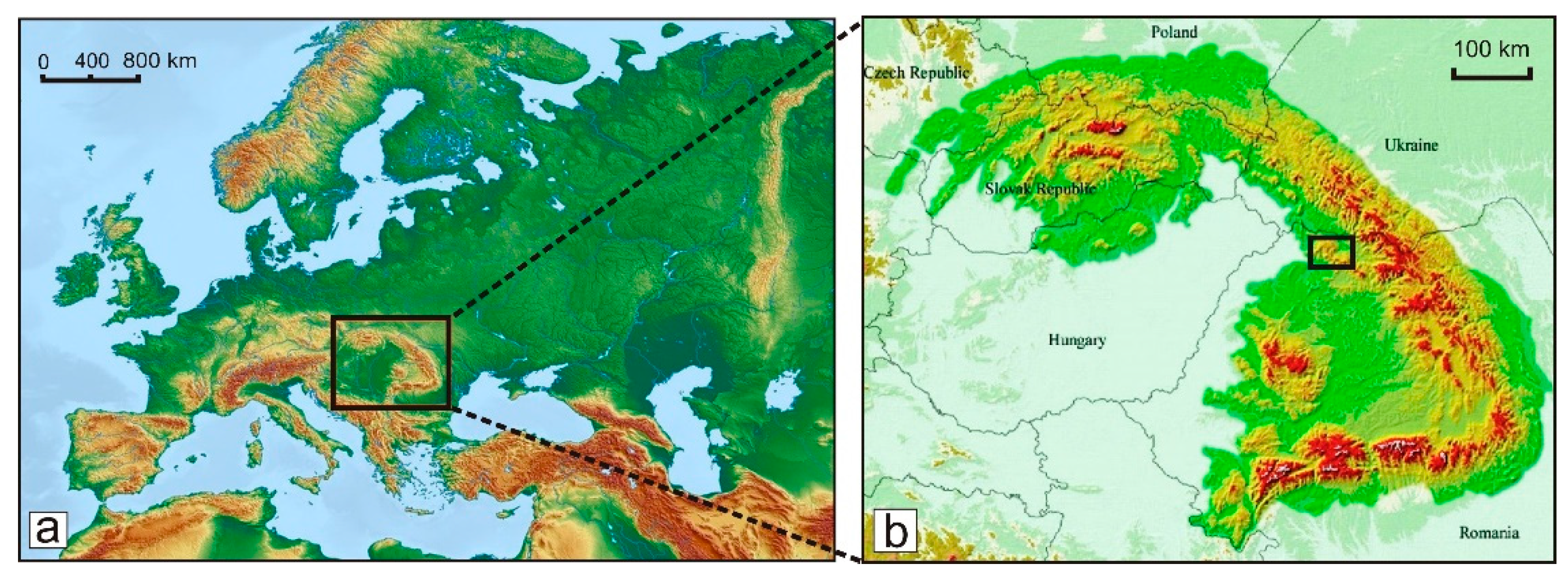
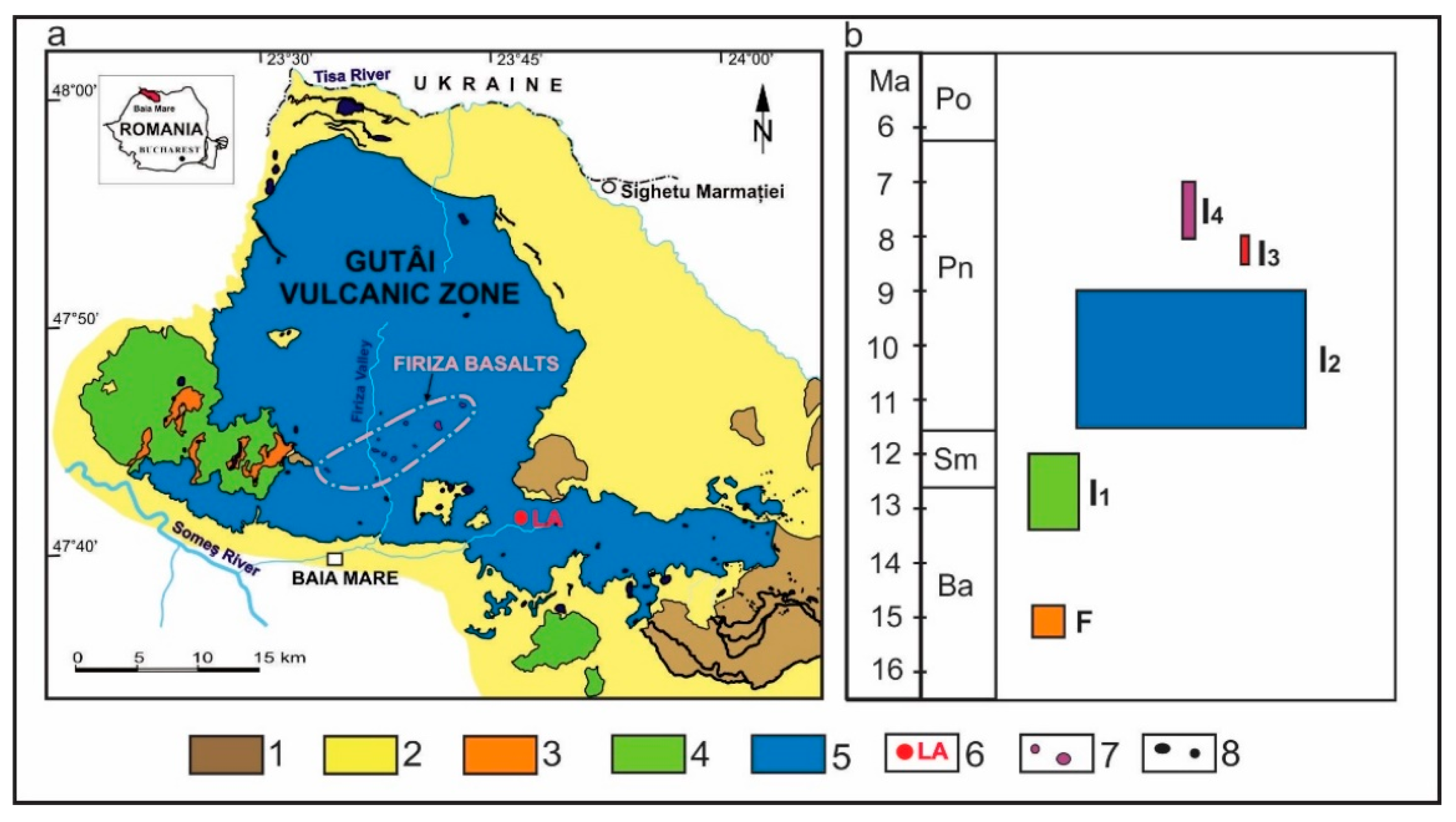
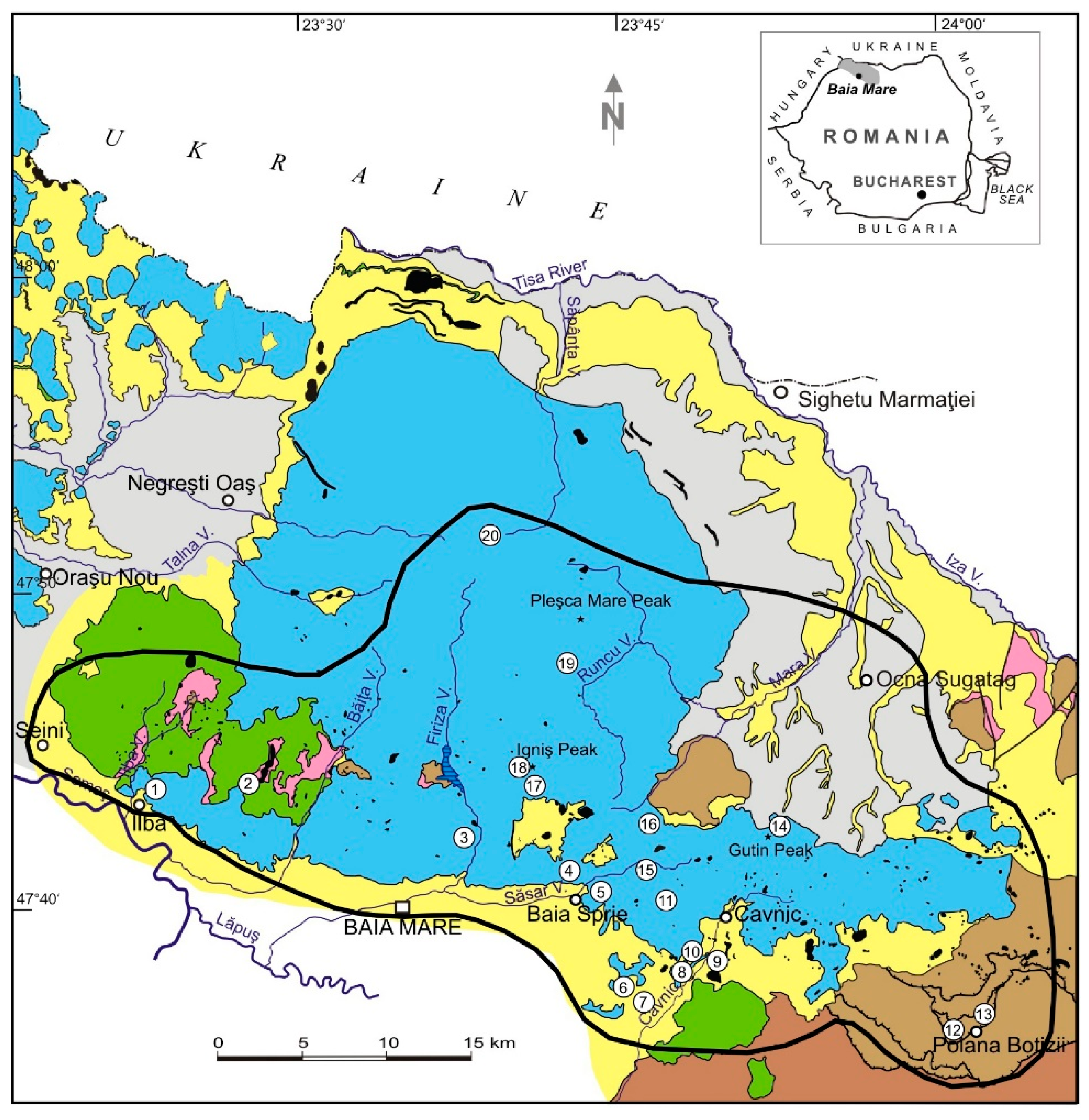
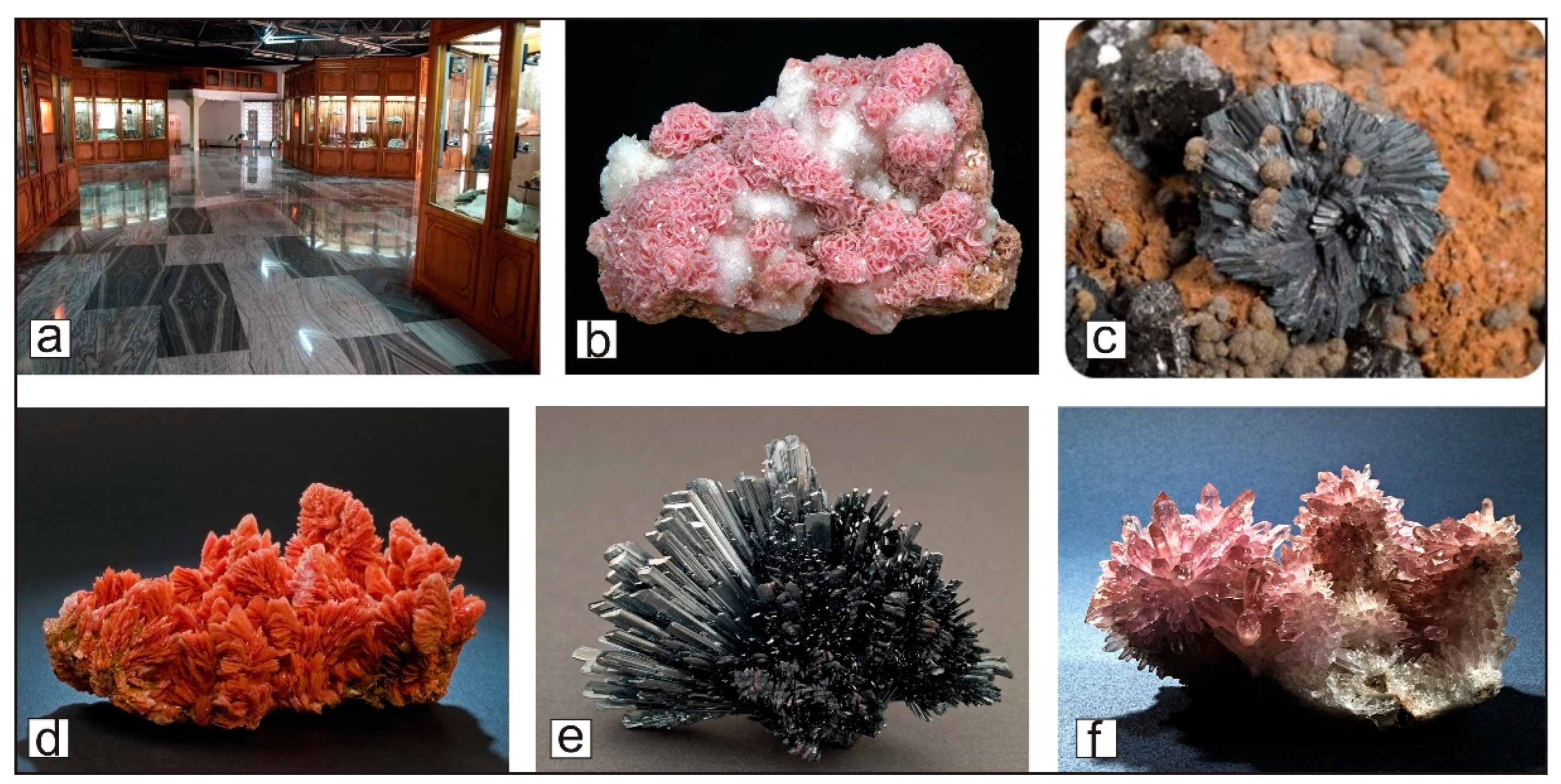
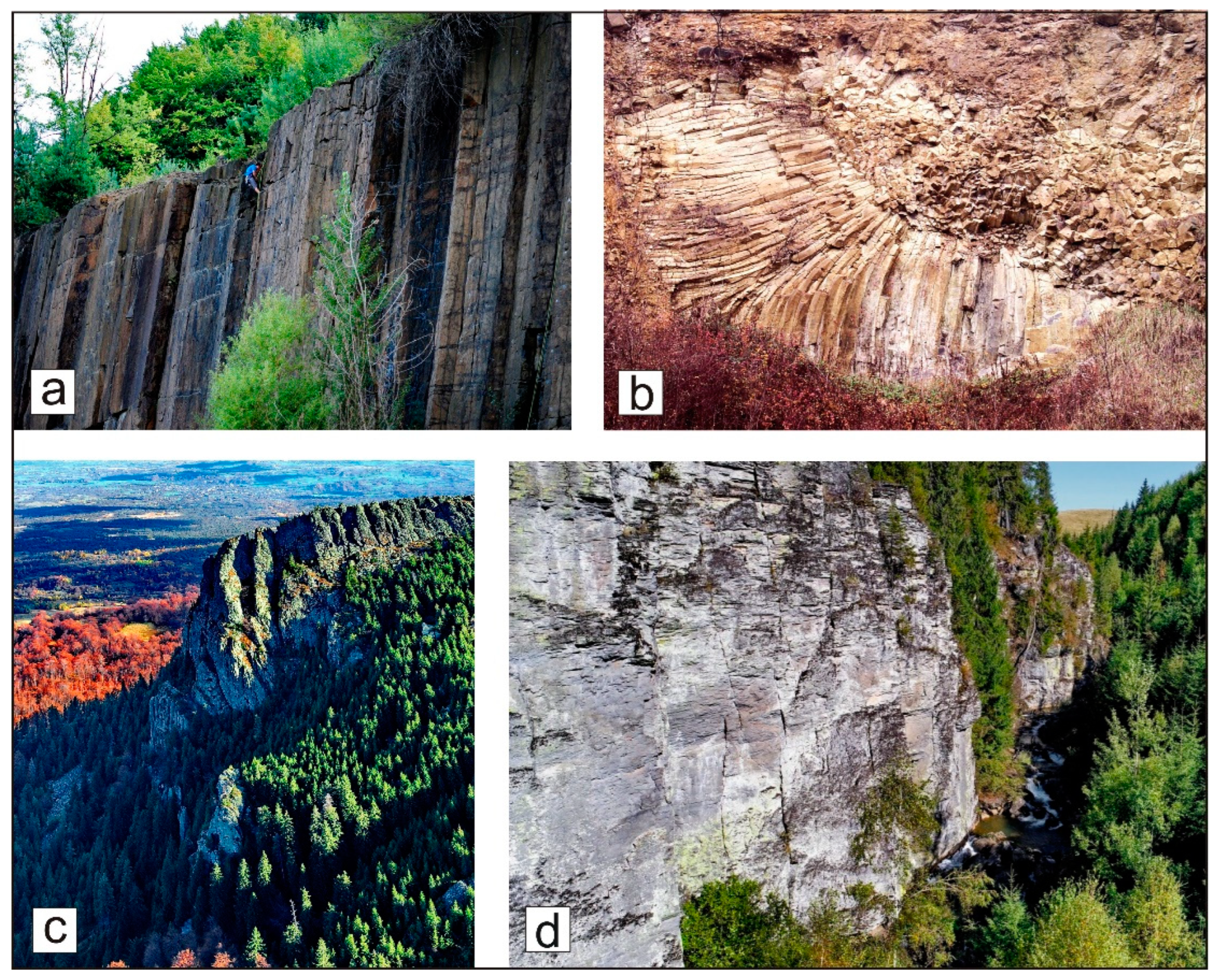
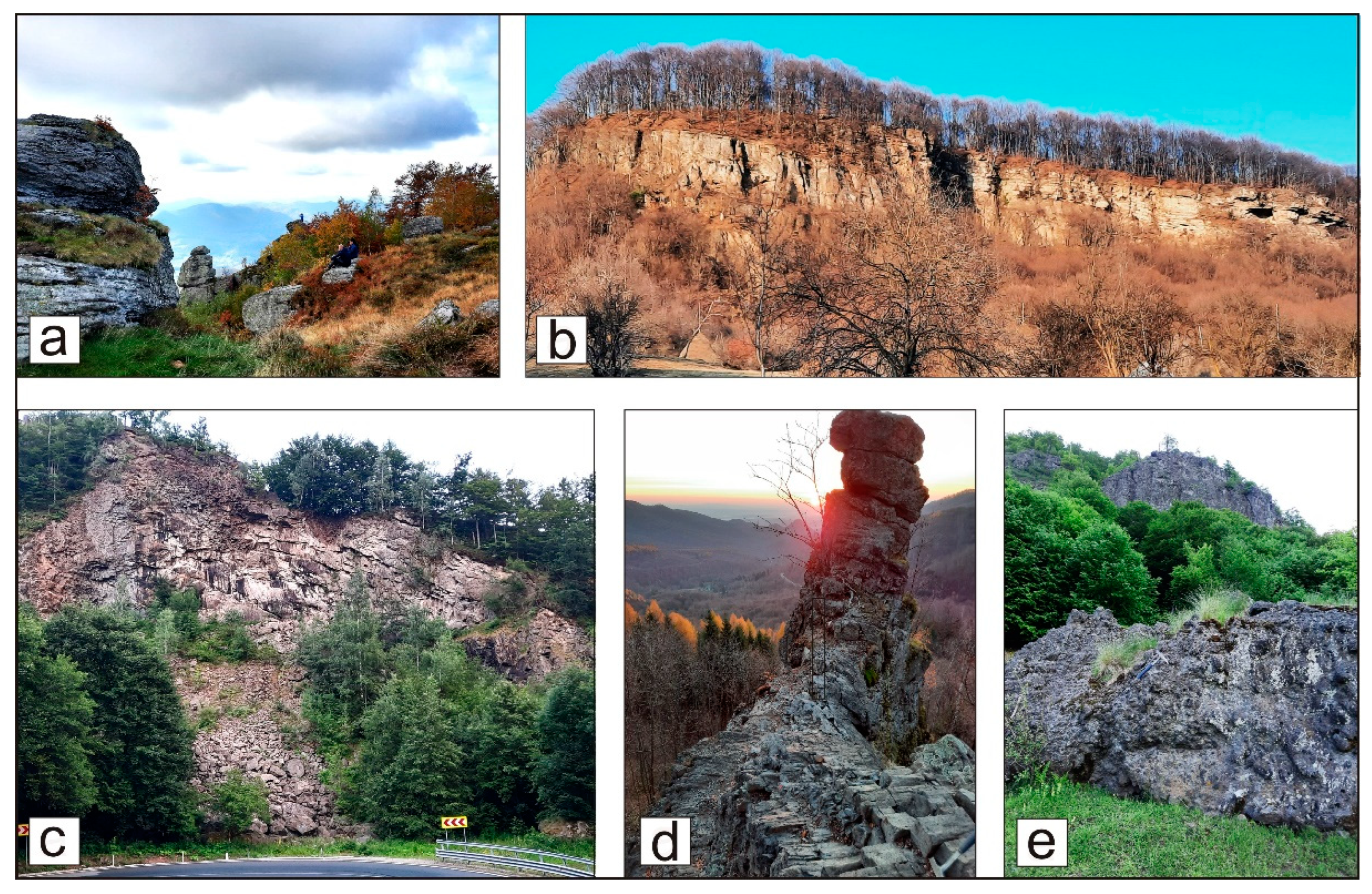

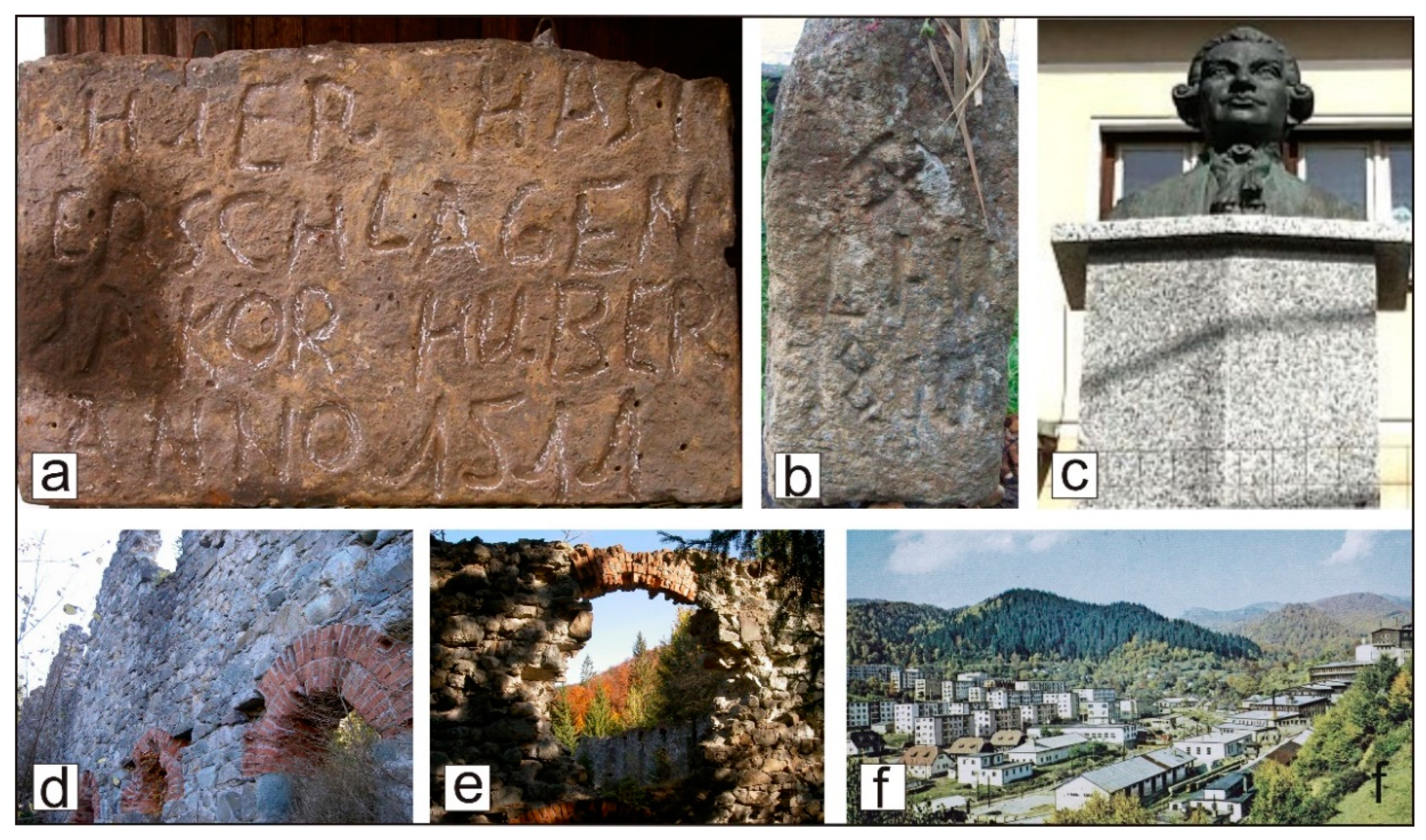
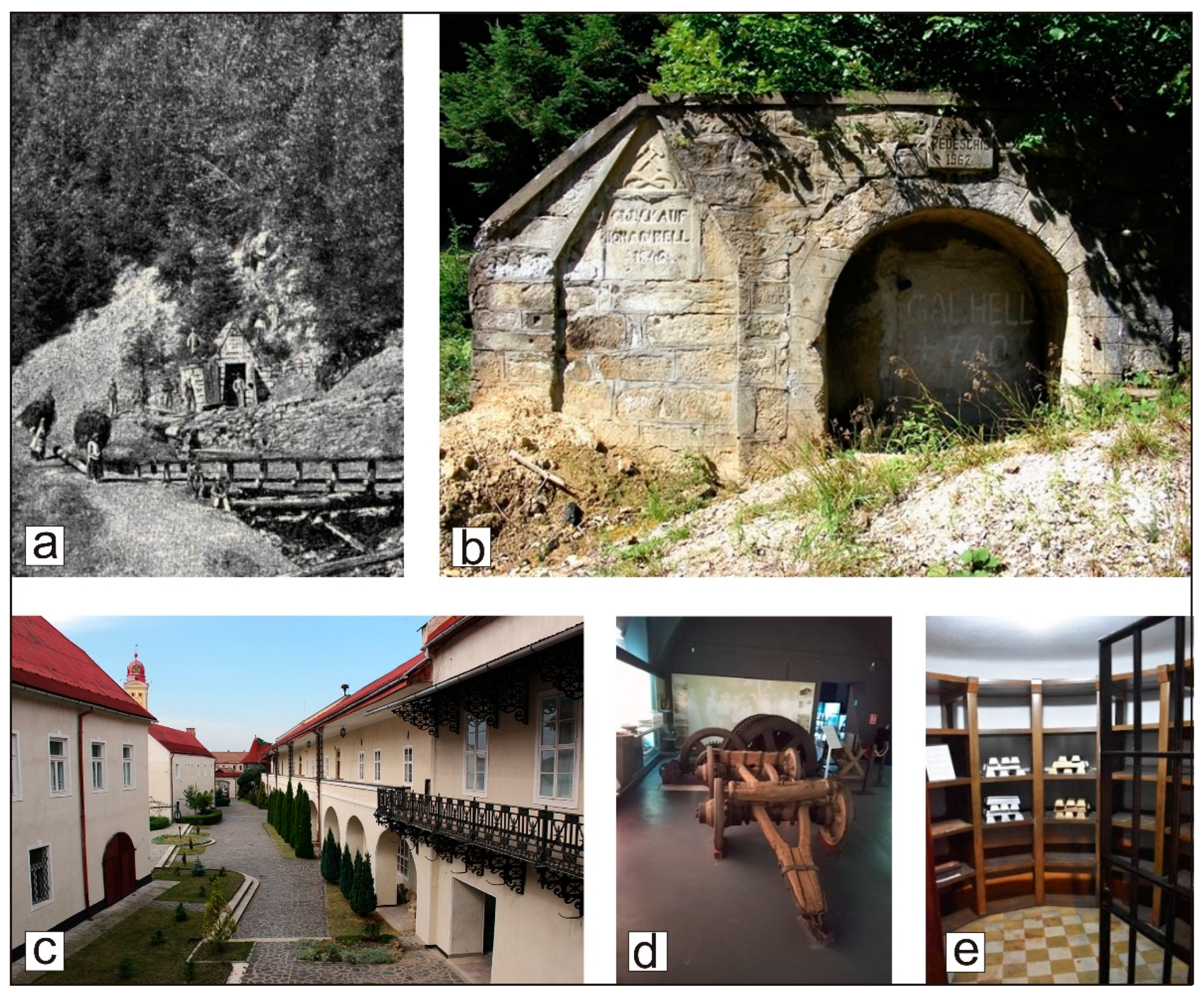
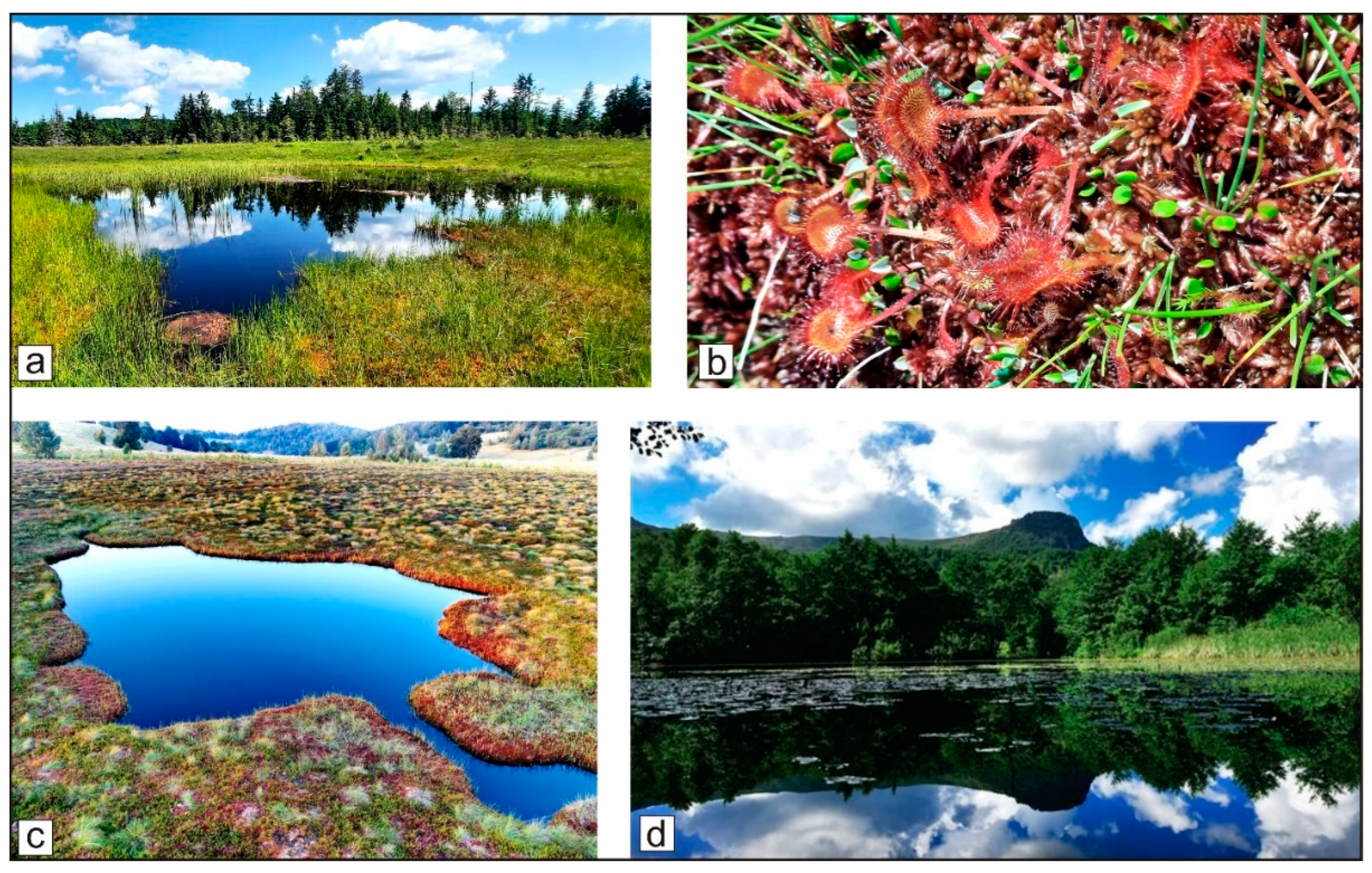
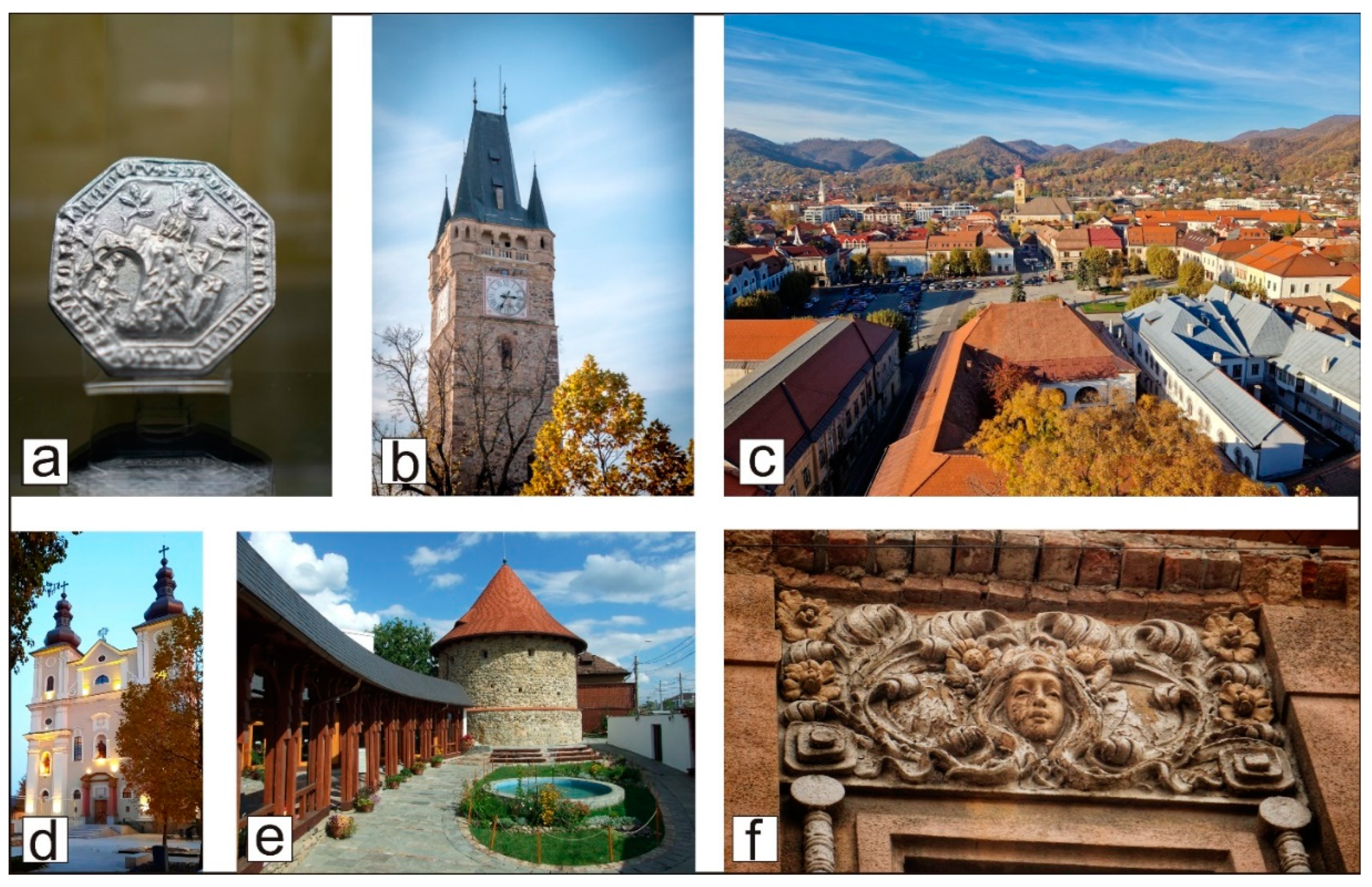
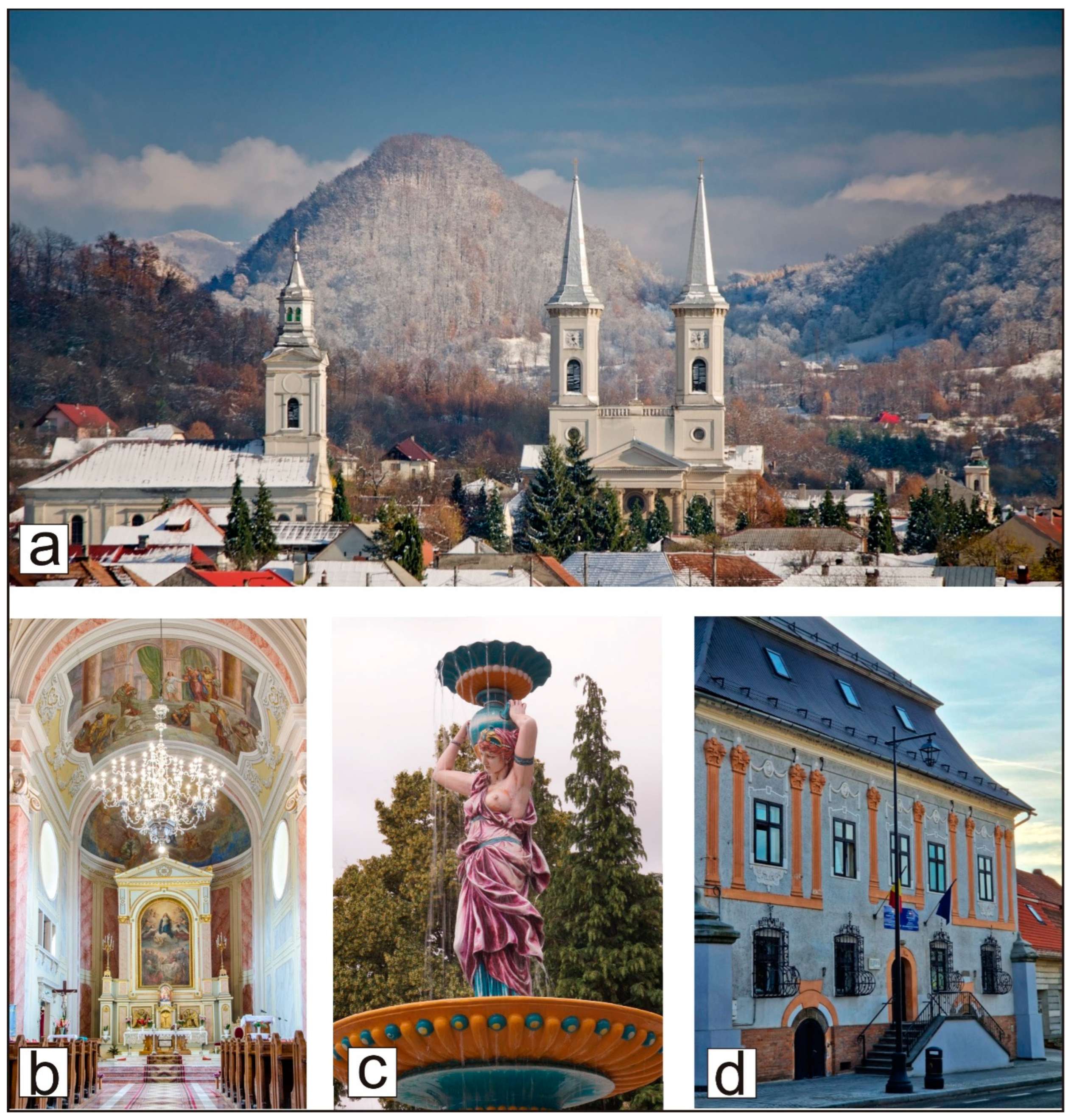
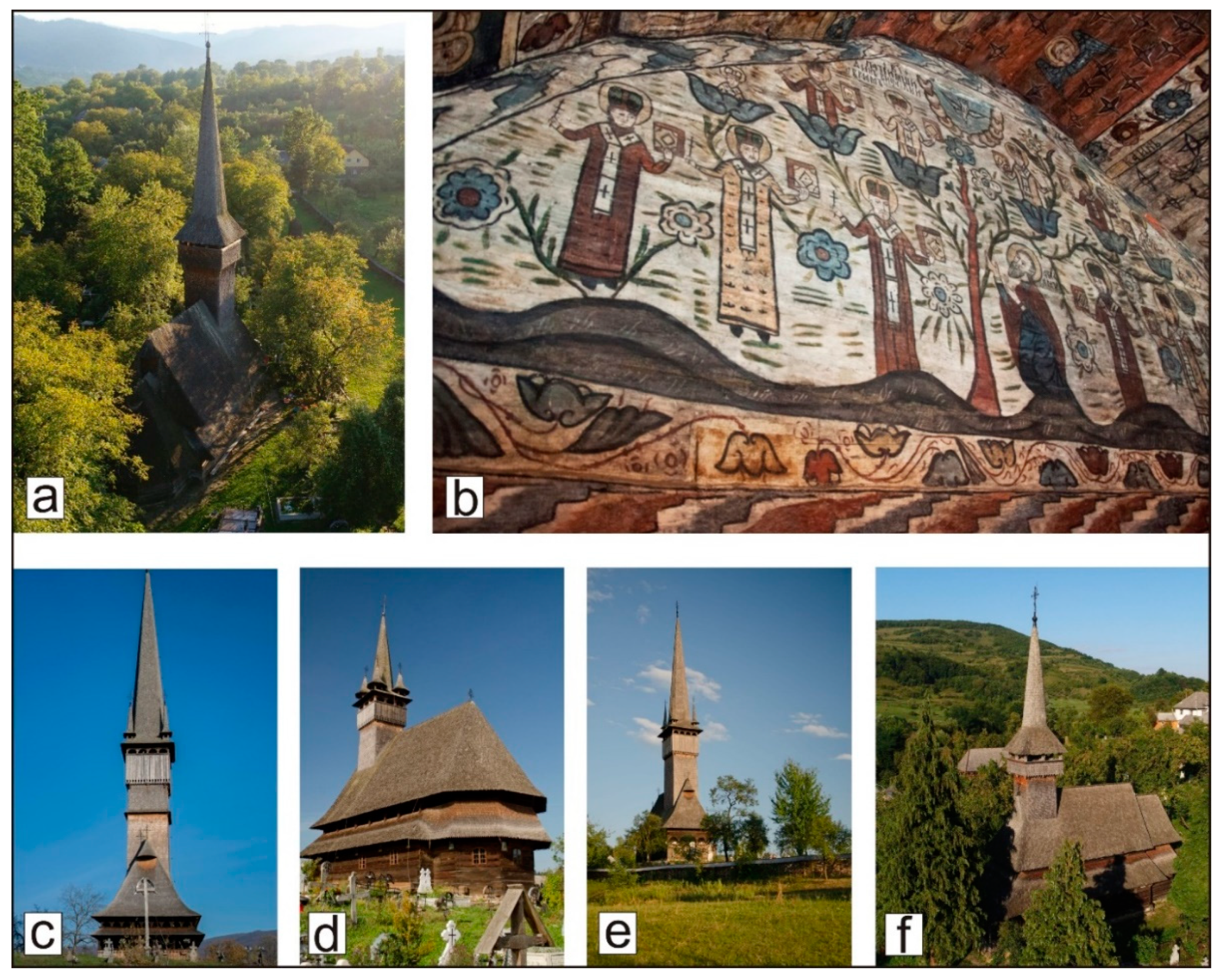
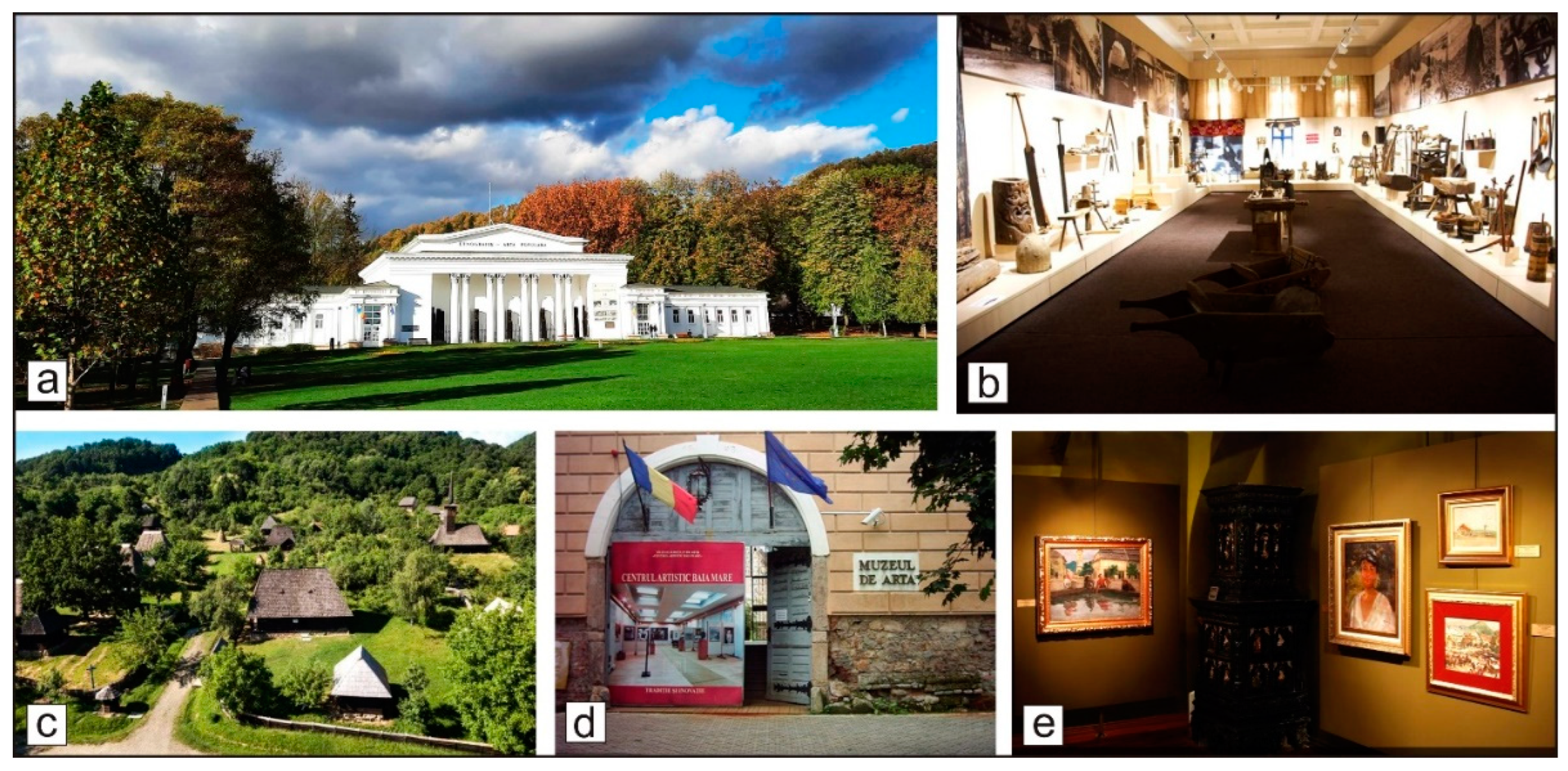
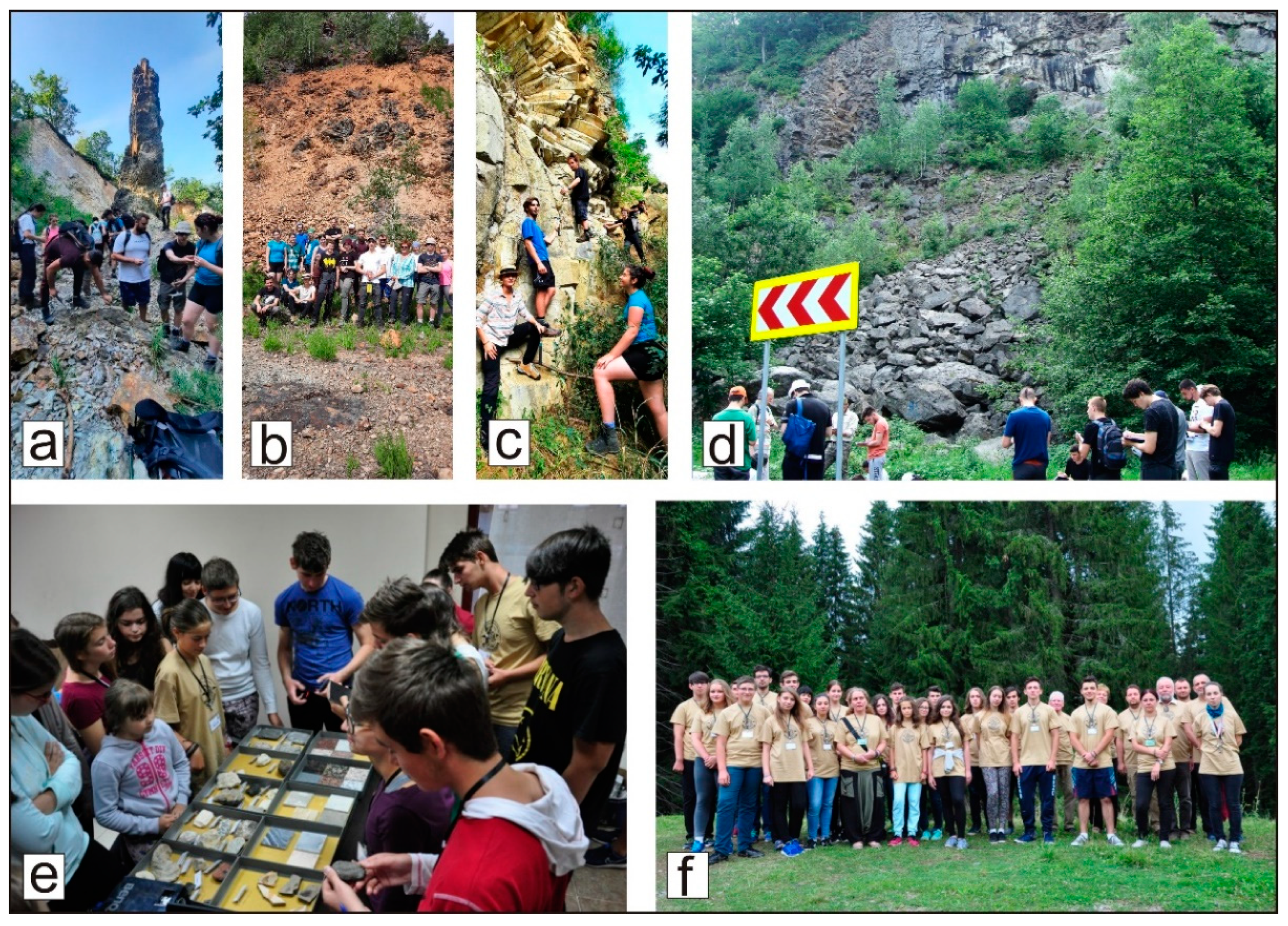
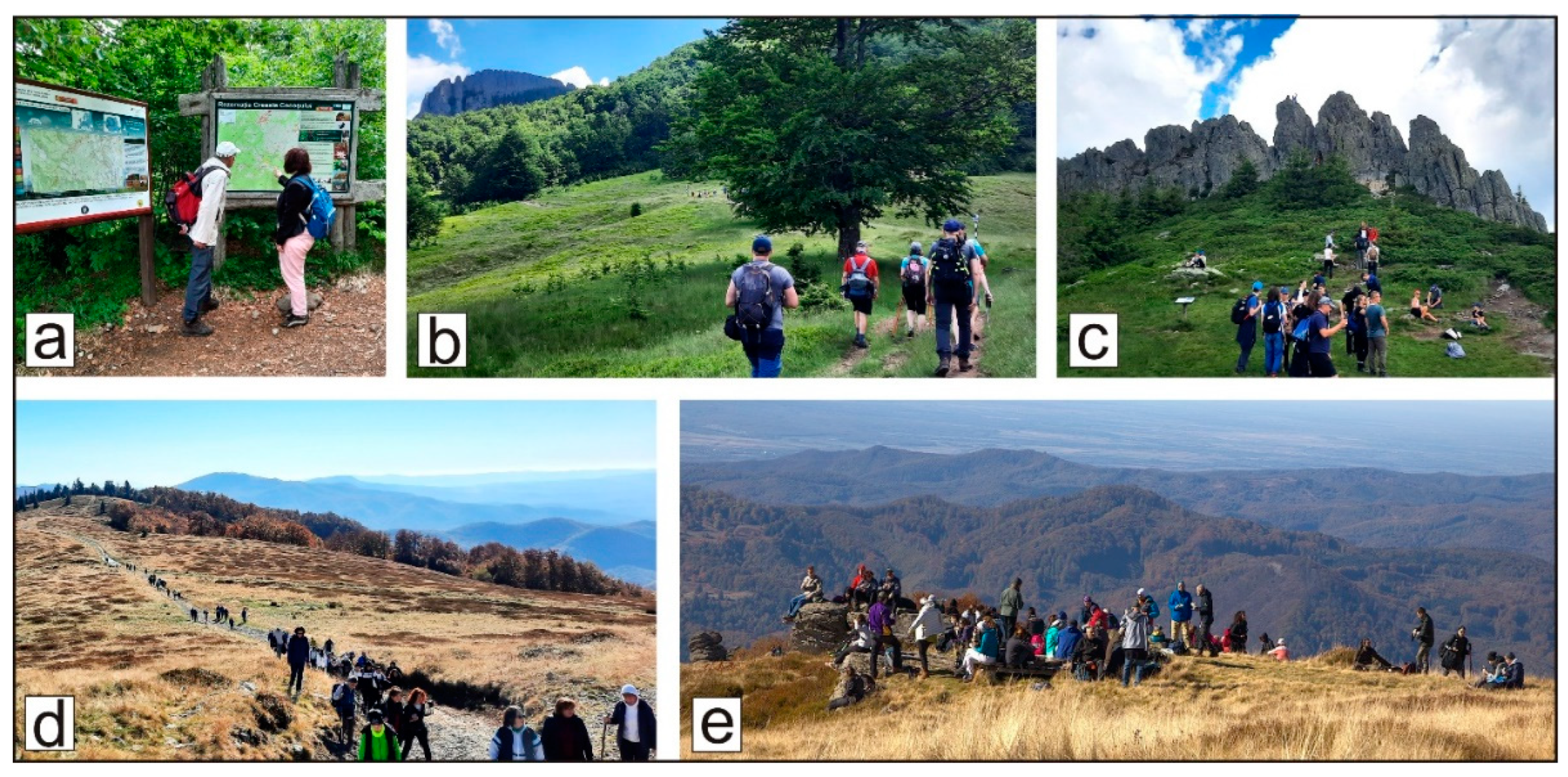
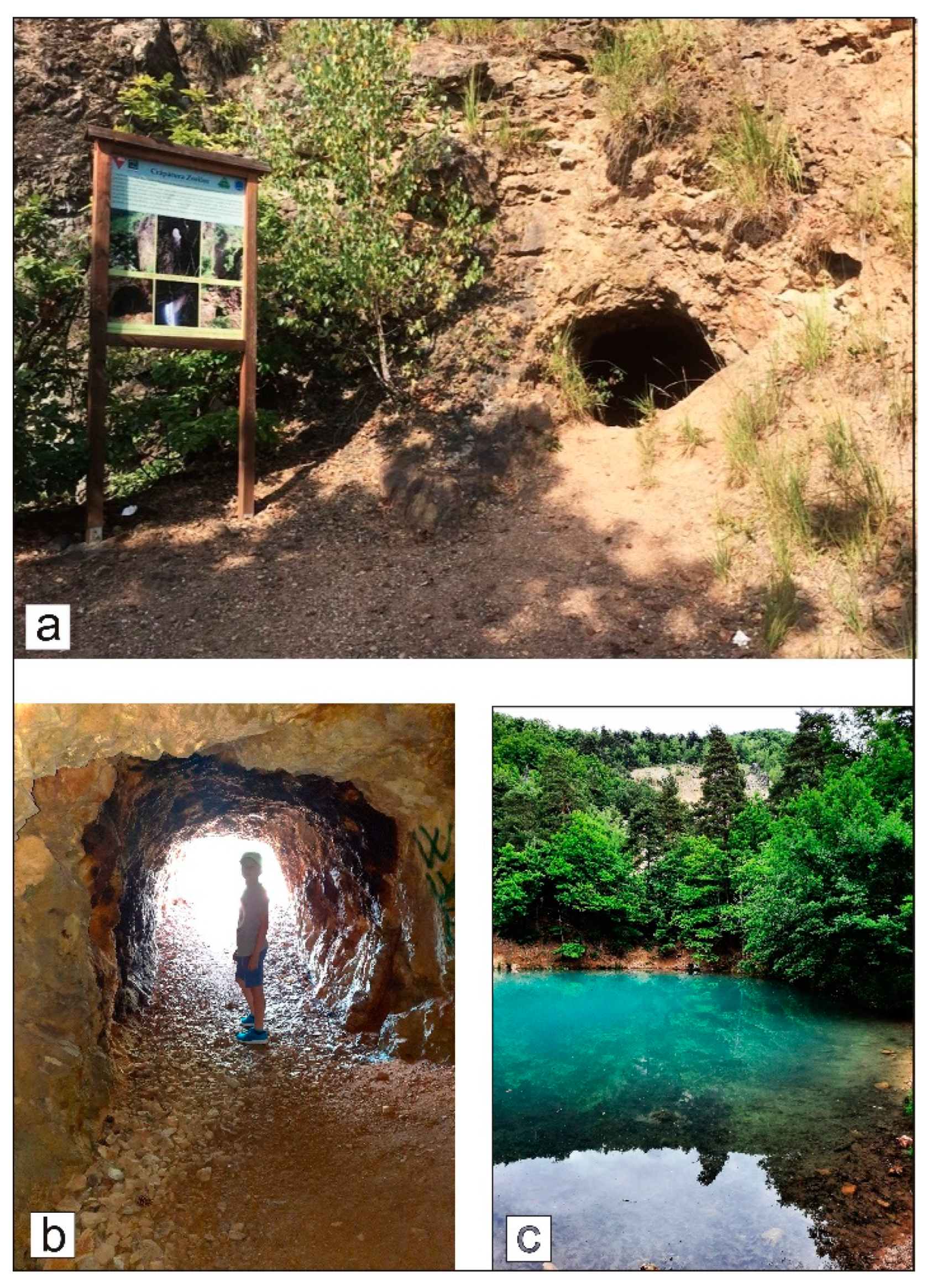
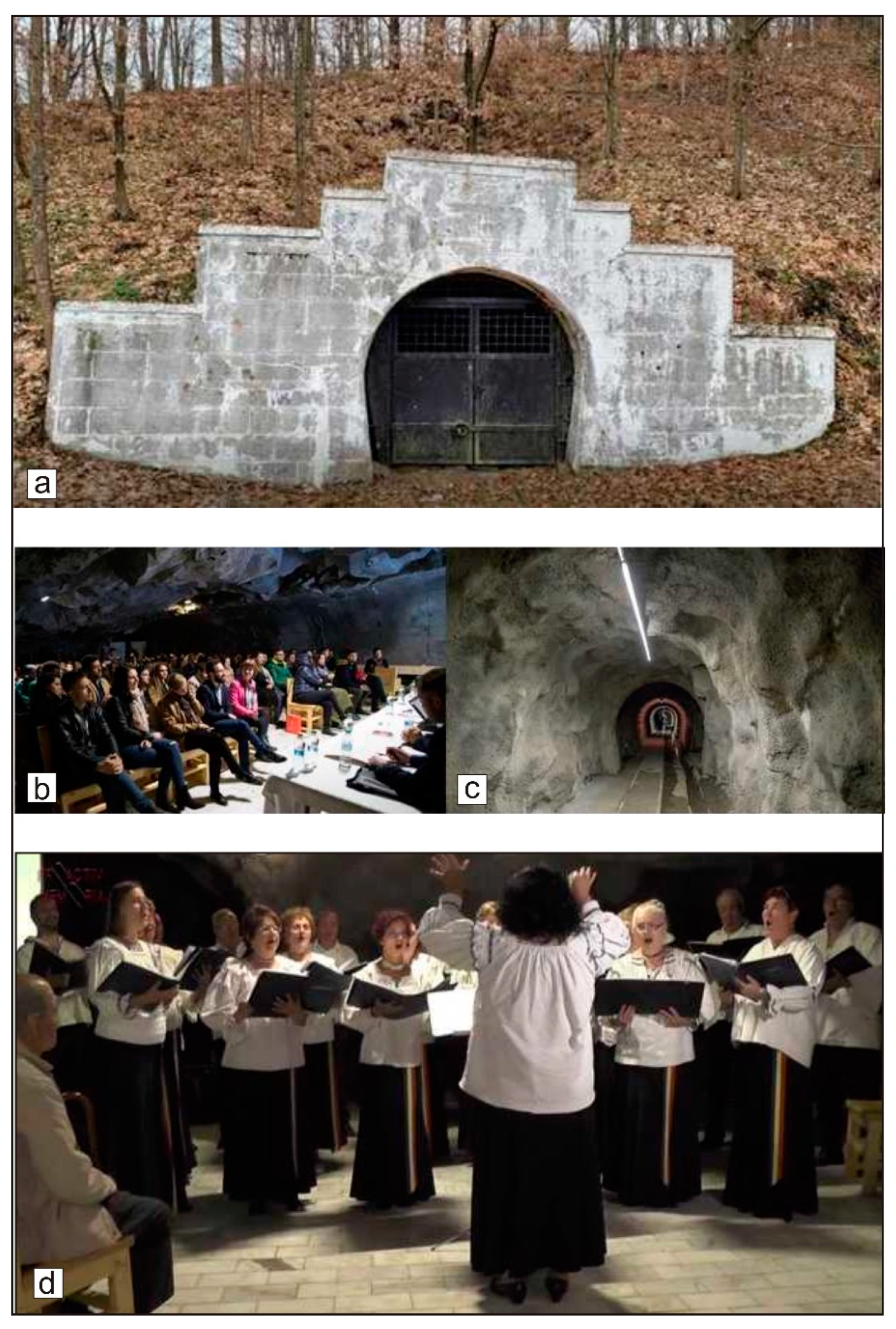
| Geosites | Geological Type (acc. Brilha, 2016 [10]) | Major Heritage Features |
|---|---|---|
| Laleaua Albă/White Tulipe composite dykes | Petrological, mineralogical, geomorphological | Two composite dykes of external zone of aphyric andesite and internal zone of macro porphyritic dacite. An “open-air mineralogical museum”: sanidine (max. 5 cm), plagioclase, quartz, biotite, amphibole, pyroxene and gabbroic enclaves (up to 90 cm) in dacite. Unique in East Carpathians volcanic range. |
| Piatra Roșie/Red Stone Șurdești | Petrological, geomorphological | Impressive escarpment within in situ and resedimented dacitic hyaloclastites; most relevant outcrop in hyaloclastite deposits in Gutâi Volcanic Zone (GVZ). |
| Pietrele Șoimului/Falcon Stones Mogoșa | Petrological, geomorphological | Steep cliffs in phreatomagmatic volcaniclastic and block-and-ash-flow deposits with many large-sized blocks detached from the high escarpment. |
| Top of the Igniș volcano | Petrological, geomorphological | Residual landforms: rock pillars, rock towers and individual tor-like forms; isolated cliffs with spectacular erosional shapes (the “Igniş Sphinx”). |
| Mogoșa composite volcano | Petrological, geomorphological | A compound volcanic dome system, built during several successive dome-forming and dome-collapse events across an unusually long-time span of activity (ca. 2 My). |
| Nistru welded ignimbrites | Petrological | A thick (30 m) welded ignimbrite sequence consisting of three units, each one topped by pumice-rich layers. |
| Poiana Botizii Pienniny Klippens | Structural, stratigraphic | The only occurrence in Romania of the Jurassic–Cretaceous rocks as remnants of an old ridge of the Tethys Ocean (separating the African–Arabian and Eurasian plates). |
| “Grădina Uriașilor”/“Giant’s Garden” Baia Sprie | Geomorphological, petrological | Cluster of andesitic breccia mega blocks at the western foot of the Mogoșa volcano edifice that prove their dome collapse origin. |
| Cavnic sill | Petrological | A basaltic andesite sill with a visible quasi-horizontal upper contact with Pannonian sedimentary deposits. |
| Dănești–Cetățele composite dome | Petrological, geomorphological | Residual volcanic relief (skeleton-like landform) on two different volcanic rocks: biotite rhyolite of Dănești dome and pyroxene dacite of Cetățele dome with spectacular gorges and rock towers. |
| Senonian red marls from Poiana Botizii | Stratigraphic, structural | Unique outcrops in the Senonian Puchov type red marls in the front of the Botiza overthrust nape. |
| Serpentinele Gutinului volcaniclastic complex | Petrological | A very thick succession of various volcanic units composed by coherent lava rocks, hyaloclastites, phreatomagmatic breccias, coarse and fine debris flows, fine volcanic epiclastic rocks (outcropping around 3 km along the national road). |
| Gutâi Northern Slope lavas plateau and Rotundu crater | Petrological, geomorphological | Extended andesitic lava flows that form typical landform (plateau-like) and a large remnant crater (ca. 3 km across) as a semicircular ridge, unique in the GVZ. |
| “Bulbucii” from Șurdești | Petrological, geomorphological | Two isolated cliffs as residual erosional landforms within lava flows and volcaniclastics belonging to the Cetățele dome in an area covered by Sarmatian and Pannonian sedimentary deposits. |
| No | Name | Location | Surface (ha) | Type | IUCN Category | Relevant Features |
|---|---|---|---|---|---|---|
| 1 | The Cave of Bones | Poiana Botizii (Băiuț) | 0.5 | Speleological | III | Ursus spelaeus bones |
| 2 | Vlășinescu Marsh | Mara (Desești) | 3 | Botanical, wetland | III | Flora and fauna species specific to wetland and peat bog areas |
| 3 | Dumitru’s Pond | Baia Mare | 3 | Botanical, wetland | III | Active peat bog, with oligotrophic bog vegetation |
| 4 | Iezerul Mare Marsh | Desești | 5 | Botanical, wetland | III | Many natural elements specific for wetlands |
| 5 | Black Pond Marsh | Strâmbu-Băiuț (Băiuț) | 1 | Botanical, wetland | III | Natural habitats and specific oligotrophic peat bog biodiversity |
| 6 | Morăreni Lake | Breb (Ocna Șugatag) | 20 | Mixed | IV | Biological diversity of aquatic ecosystem, with representative flora |
| 7 | Crăiască Forest | Ocna Șugatag | 44 | Forestry | IV | Vegetation characteristic for this forest: lark and durmast oak |
| 8 | Comja Pine Tree Forest | Seini | 0.5 | Forestry | IV | Natural habitats, wild flora and fauna and biological diversity |
| 9 | Baia Mare edible chestnut trees forest | Tăuții Magherăuș, Baia Mare, Baia Sprie | 500 | Forestry | IV | Sweet chestnut tree population, at the northernmost natural limit of the species |
| No | Name | Locality | Major Heritage Features | Dating |
|---|---|---|---|---|
| 1 | Historic center of Baia Mare city | Baia Mare | Once the medieval town of Rivulus Dominarum, the heart of the modern city features heritage buildings from the 15th to 20th centuries in Gothic, Baroque, neoclassical, eclectic, and secession styles. | 15–19th centuries |
| 2 | Stephen’s Tower | Baia Mare city | The single remnant of the iconic medieval “Saint Stephen” Church, which has endured fires, damage, and restorations during the centuries. It preserves Gothic features, old bells and clock mechanism, and its lookout platform offers panoramic views of the city. | 1347 |
| 3 | Church of St. Anton | Baia Mare city | The city’s oldest surviving church, whose building has undergone numerous architectural changes over the centuries. | 1402 |
| 4 | Iancu de Hunedoara house | Baia Mare city | The oldest building in the city, built in 1446 by the King of Hungary, János Hunyadi (Iancu de Hunedoara), as a residence for his wife, Elisabeta. | 15th century |
| 5 | Butchers’ Bastion (Ammunition Tower) | Baia Mare city | A structure built to reinforce the walls against attacks, serving as a strategic defense point near the medieval town’s southern entrance. The recent restoration was completed in 2011 and gave the bastion its current appearance. | 14–15th centuries |
| 6 | “Holy Trinity” Church of the former Jesuit monastery | Baia Mare city | Built by the Jesuits, the oldest Baroque church in Transylvania and a key landmark for Baia Mare’s Roman Catholic community. | 1717–1719 |
| 7 | The historical center of the Baia Sprie city | Baia Sprie town | “A” value group monument featuring 18th and 19th century religious and civil buildings. | 18th century |
| 8 | “Holy Mary” Roman Catholic church | Baia Sprie town | The most imposing building in the historic center of the town, renowned for its monumental neoclassical architecture. | 1846–1858 |
| No | Name | Locality | Major Heritage Features | Dating |
|---|---|---|---|---|
| 1 | “Sf. Nicolae” Josani | Budești | UNESCO World Heritage site, Maramureș county’s largest church when built and still impresses with its expansive width. Inside, it features icons and royal doors painted during 1760–1762. | 1643 |
| 2 | “Cuvioasa Paraschiva “ | Desești | UNESCO-listed wooden church with well-preserved murals painted in 1780, the only location in Maramureș county where religious services are still regularly held. | 1770 |
| 3 | “Sf. Arhangheli Mihail și Gavril” | Plopiș (Șișești) | UNESCO-listed monument, with a stunning sense of proportions, preserving interior murals painted in 1811. | 1798 |
| 4 | “Cuvioasa Paraschiva” | Poienile Izei | UNESCO-listed wooden church particularly famous for the expressive scenes of the Final Judgment depicted in the pronaos. | 1700 |
| 5 | “Sf. Arhangheli Mihail și Gavril” | Șurdești (Șișești) | Oak-built UNESCO-listed church with a 54 m high tower, the tallest wooden church in the world dating before the 20th century. | 1766 |
| 1. Synthesis of Local Geodiversity (A) | 2. Synthesis of Local Biodiversity (B) | 3. Document Local Cultural Values (C) |
| Activities of research and integrated evaluation of geodiversity, biodiversity, and cultural diversity involves a comprehensive and holistic assessment of the three key components and identification of its geological heritage (GH), natural heritage (NH) and its cultural diversity and cultural heritage (CH). | ||
| Geological Heritage (GH) Geological heritage refers to the significant geological features, formations, and processes that have scientific, educational, and touristic value. | Natural Heritage (NH) Natural heritage, except geological heritage, encompasses all the living components of nature that are considered valuable for their biodiversity, ecosystems, and ecotourism significance. | Cultural Heritage (CH) Practices and traditions that are intertwined with the land, its people, and its history. It is closely connected to the GH and NH and plays an essential role in shaping the identity and the visitor experience. |
| 4. Realize Two SWOT Analyses for both the “Gutâi-Maramureș” Geopark area and “Gutâi-Maramureș” Geopark project. The results will be used in further geopark project steps to define the optimum territory, its core values, comply with UNESCO Geopark Program requirements and optimize the cooperation and support with local administrations and partners. | ||
| 5. Develop Geoeducation and Sustainable Tourism Pilot Activities A way to foster community engagement, raise awareness of the region’s geological, natural and cultural significance, and support local economies. Both approaches are integral to ensuring that the “Gutâi-Maramureș” Geopark area benefits from its rich heritage in a responsible way. | ||
| Strengths | Weaknesses |
| Very rich geological and mining heritage well documented and fulfilling the basic requirement for a UNESCO geopark and strong foundation for scientific, educational, tourism, economic initiatives | Not enough administrative partners and funds to stop the loss of the mining heritage, requiring renovation, protection action plans and significant remediation efforts |
| Geodiversity covers different topics and ages, with unique geologic evolution and volcanic landscape making the geopark an added value when will join the Global Geoparks Network | Takes time to develop the geopark infrastructure to support sustainable tourism and promote the geological, natural and cultural heritage and prove the role a geopark can play |
| Rich biodiversity and specific landscapes—the area has diverse ecosystems and scenic landscapes, rich protected areas, enhancing its value for tourists and researchers | Different mining infrastructure belongs to different owners (communities, former mining company, private ones) and will take time to convince them to cooperate |
| Cultural and historical significance with a unique cultural identity shaped by centuries of mining and offering a unique blend of industrial heritage and traditional practices that can attract cultural tourism | Local mayoralties are not very used to cooperating outside of their territories |
| Existence of another UNESCO designations and protected areas with great potential for common promotion | Lack of public awareness of geological heritage and the role of a geopark |
| Existence of a unique mineralogical museum and other dedicated museum for history and culture | Lack of geology in school curricula |
| Opportunities | Threats |
| Establishing the geopark could be part of the county strategy to promote sustainable tourism, balancing economic growth with heritage preservation and strengthen the cultural identity | Heritage degradation due to the lack of coherent local common strategies for heritage conservation |
| The geopark can serve as a hub for geological and environmental education, attracting researchers, students, and enthusiasts | Misunderstanding the geopark potential for local development or lack of support in project development |
| A geopark strategy could gather and motivate different groups and local people to cooperate and contribute to geopark brand development as a common international value | Competition with other projects and initiatives |
| Offers the possibility for international cooperation and promotion within the EGN and GGN even at this stage of the project through the Romanian Geoparks Network, ProGEO Conferences, Erasmus+ projects and other similar programs | Insufficient funding and resources for the establishment and maintenance of the geopark may be challenging, especially in the initial stages |
| Involving local communities in the geopark’s development and activities can create jobs, support local businesses, and foster a sense of ownership and pride | |
| Potential for projects and financial and administrative support for local communities and initiatives related to the geopark project |
Disclaimer/Publisher’s Note: The statements, opinions and data contained in all publications are solely those of the individual author(s) and contributor(s) and not of MDPI and/or the editor(s). MDPI and/or the editor(s) disclaim responsibility for any injury to people or property resulting from any ideas, methods, instructions or products referred to in the content. |
© 2025 by the authors. Licensee MDPI, Basel, Switzerland. This article is an open access article distributed under the terms and conditions of the Creative Commons Attribution (CC BY) license (https://creativecommons.org/licenses/by/4.0/).
Share and Cite
Kovacs, M.; Szakács, A.; Andrășanu, A.; Denuț, I. The “Gutâi-Maramureș” UNESCO Geopark Project Development and Heritage Values-Based Sustainable Tourism in the Gutâi Volcanic Zone, East Carpathians (Romania). Land 2025, 14, 726. https://doi.org/10.3390/land14040726
Kovacs M, Szakács A, Andrășanu A, Denuț I. The “Gutâi-Maramureș” UNESCO Geopark Project Development and Heritage Values-Based Sustainable Tourism in the Gutâi Volcanic Zone, East Carpathians (Romania). Land. 2025; 14(4):726. https://doi.org/10.3390/land14040726
Chicago/Turabian StyleKovacs, Marinel, Alexandru Szakács, Alexandru Andrășanu, and Ioan Denuț. 2025. "The “Gutâi-Maramureș” UNESCO Geopark Project Development and Heritage Values-Based Sustainable Tourism in the Gutâi Volcanic Zone, East Carpathians (Romania)" Land 14, no. 4: 726. https://doi.org/10.3390/land14040726
APA StyleKovacs, M., Szakács, A., Andrășanu, A., & Denuț, I. (2025). The “Gutâi-Maramureș” UNESCO Geopark Project Development and Heritage Values-Based Sustainable Tourism in the Gutâi Volcanic Zone, East Carpathians (Romania). Land, 14(4), 726. https://doi.org/10.3390/land14040726







